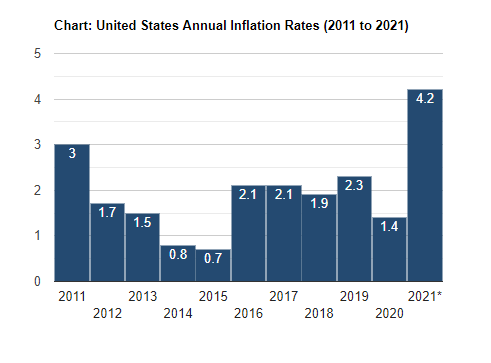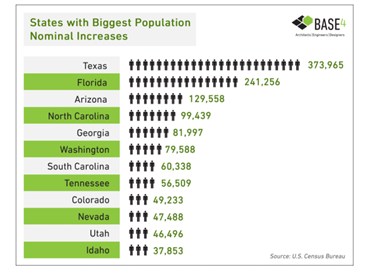These days it seems that nearly everyone has an opinion about the state of our nation’s economy, and the subject of inflation is at the forefront of these debates. The administration tells us there is no inflation. On the other hand the Federal Reserve says it’s just temporary. It does make you wonder how both can be true.
The simple definition of inflation is prices of goods rising over time and the value of currency declining. It takes more money to buy what we need. Some spend instead of saving because they know their money will buy less and earn less in the future. Many refer to inflation as a hidden tax. The middle class and the poor are affected the most of course. Those on fixed incomes really suffer.
The Federalist explains inflation is calculated by using the “Consumer Price Index, a mathematical tool that measures the prices change for a selected basket of goods and services.”
Economists say some inflation is good for the economy. They like it at approximately 2%.
 Source: usinflationcalculator.com
Source: usinflationcalculator.com
CNN Business reported recently, “prices for finished goods increased by the largest amount since the government started tracking that specific measure in 2009. The biggest driver was a sharp 8.8% jump in gasoline prices.”
Fortune is one of many outlets reporting lumber prices rising 280%! That means it costs more to build a house. Less people can afford to build the same house they might have afforded a year ago. Housing values rising and low inventory, has resulted in a seller’s market.
Economists explain that if the Federal Reserve decides to increase the money supply, commonly called printing money, and the supply of goods does not increase, then prices will go up. People have more cash but there are not enough goods to buy.
Unemployment seems to follow inflation. An article in Forbes several years ago outlined the period from 1971 to 1991 where unemployment increased along with inflation.
Lately we’ve been hearing about the shortage of workers and at the same time, high unemployment. Enhanced unemployment benefits make it more advantageous for some to stay home. Many are still afraid of getting Covid. The Wall Street Journal also cites businesses opening before schools make it difficult for parents to return to work.
There is also the fact that many people don’t have the skills for the jobs that are available and don’t want to switch careers. Businesses are trying to attract workers with signing bonuses and higher wages. But a lot of these jobs are in the restaurant, construction, manufacturing and logistics fields. Moving companies need more workers.
There has been an exodus from big cities, fueled by Covid, lockdowns, job loss, astronomically rising crime rates, rising cost of living, school closings, etc. Many have moved to a neighboring county or state to escape taxes, restrictions and/or crime. Many others have moved quite far.


Some states will be the beneficiaries of new talent and others will lose talent. What kind of talent is moving to, for example, Florida? How will that affect the residents already here? Schools will have many more students. There will be more competition for the available jobs. How will the demographics change? How will public policy change? I have seen many on social media issue the warning, “Don’t New York My Florida.”
What kind of jobs are currently available in our area? Looking at CareerSource, we find most jobs are in the retail, hospitality, medical and technical fields. There are some administrative jobs available. Generally speaking, the retail, hospitality and administrative jobs don’t offer high wages.
Economic development organizations have their work cut out for them. Even more than before, they will have to help attract talent, identify and monitor talent, attract high wage businesses, encourage/facilitate expansion, work with educational institutions and CareerSource to help the working population match their talents or develop new skills for the jobs available. All the while, they will need to keep their finger on the pulse of community health and safety. There are a lot of factors at work right now. It sometimes feels like a perfect storm of factors coming together. Leading to what exactly, we don’t know.